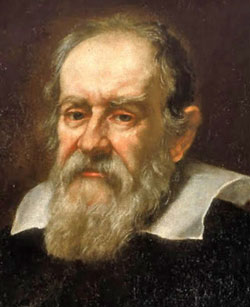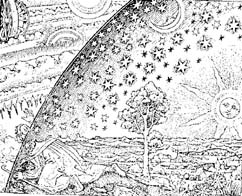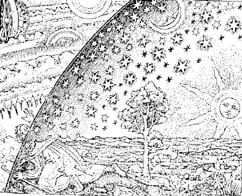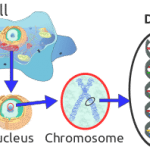Creationists are often accused (by Christians opposed to their view) of making the same mistake as the Roman Catholic Church did at the time of Galileo. Then, the institutional Church insisted that the Bible taught that the sun went around the earth. After it was shown by Galileo that the opposite was true, believers found that they could comfortably accommodate this new fact, without any problem to their belief in the Bible. However, the historical events surrounding Galileo should be a warning to theistic evolutionists and long-agers, not to the Genesis creation movement.
The background

Over two millennia ago, Aristotle (384–322 BC) taught that the earth was the centre of a ‘perfect’ universe in which the movements of the stars were circular and never ending.
Ptolemy (AD 2nd century) expanded these ideas into what became known as the Ptolemaic system (see box).
Then in the 16th century, Copernicus (1473–1543) postulated as a better explanation that the earth and planets revolved around the sun.1,2
In the 17th century, Galileo (1564–1642), with his telescope, was able to carry out repeated and repeatable observations which refuted Aristotle and Ptolemy, and supported Copernicus. For example, he observed that the sun had spots which moved across its surface, showing that the sun was not ‘perfect’ and it itself rotated; he observed the phases of Venus, showing that Venus must orbit the sun; and he discovered four moons that revolve around Jupiter, not the Earth, showing that the Earth was not the centre of everything. In 1618, he observed three comets pass effortlessly through Ptolemy’s crystalline spheres (in which the planets and stars supposedly moved around the Earth), showing that these spheres must be imaginary.
The heliocentric (from Greek helios = sun) or Copernican system opposed the views of the astronomer-philosophers of the day, who earned their livelihood by teaching Aristotle and Ptolemy, and so were biased against change. They therefore either ignored, ridiculed, destroyed, or hostilely opposed Galileo’ ’s writings. Many Church leaders allowed themselves to be persuaded by the Aristotelians at the universities that the geocentric (earth-centred) system was taught in Scripture and that Galileo was contradicting the Bible. They therefore bitterly opposed Galileo to the extent of forcing him on pain of death to repudiate his findings.
This was because:
- The Church leaders had accepted as dogma the belief system of the pagan (i.e. non-Christian) philosophers, Aristotle and Ptolemy, which had become the worldview of the then scientific establishment. The result was that Church leaders were using the knowledge of the day to interpret Scripture, instead of using the Bible to evaluate the knowledge of the day.
- They clung to the ‘majority opinion’ about the universe and rejected the ‘minority view’ of Copernicus and Galileo, even after Galileo had presented indisputable evidence based on repeatable scientific observations that the majority was wrong.
- They picked out a few verses from the Bible which they thought said that the sun moved around the earth, but they failed to realize that Bible texts must be understood in terms of what the author intended to convey. Thus, when Moses wrote of the ‘risen’ sun (Genesis 19:23) and sun ‘set’ (Genesis 28:11), his purpose was not to formulate an astronomical dictum. Rather he, by God’s spirit, was using the language of appearance so that his readers would easily understand what time of day he was talking about.3 And it is perfectly valid in physics to describe motion relative to the most convenient reference frame, which in this case is the earth. See the sub-article Sunspots, Galileo and heliocentrism.
This plain meaning (the time of day) is perfectly satisfied by the language of appearance and does not demand the secondary deduction that it is the sun itself which moves. Indeed, this is exactly the same thing that scientists do today in weather reports when they give the times of ‘sunrise’ and ‘sunset’. They are using the language of appearance, and using the earth as the reference frame. A convenient figure of speech does not invalidate science; nor does it invalidate the Bible.
Likewise verses such as Psalm 19:6 and 93:1, which the writer(s) clearly meant to be poetic expressions, were given a literal meaning.4,5
Today
Today we live in a world where most of the scientific establishment is heavily biased in favour of naturalism (the belief that everything can be explained by natural causes) and long ages. The scientific establishment propagates this belief system by claiming that everything in the universe originated in a big bang, and that all things are the result of evolution over billions of years. Indeed, many astronomers, scientists and teachers today have built their careers and earn their livelihood by teaching these theories.
However, these ideas, like Ptolemy’s, although ingenious and possibly plausible to atheists, are loaded with complications and contradictions, and are simply wrong.6
At the same time there is a minority of scientists, the creationists, who hold the opposing view that the Bible provides a better explanation of how the universe and life came into existence—created directly by God—and that the evidence from design, the fossil record, information theory, etc., is what one would expect if this is so. All such evidence, like Galileo’s, is ignored, ridiculed, concealed, or hostilely opposed by the establishment.
And once again many Church leaders have allowed themselves to be persuaded by the ‘science’ taught at the universities; they get around the atheistic part by telling all that the big bang, billions of years, and evolution are all compatible with Scripture. This inevitably leads them to oppose the minority (creationist) view.
This is because:
- Such Church leaders have accepted as dogma the belief system and philosophies of non-Christian (i.e. pagan) scientists, like Charles Darwin, Richard Dawkins, Stephen Jay Gould, et al. Thus, like their 17th century predecessors, they are using the ‘knowledge’ of the day to interpret Scripture, instead of using the Bible to evaluate the knowledge of the day.
- They cling to the majority opinion and reject the minority view, despite the fact that there are many observations that uphold a young age and speak against an old age of the earth and universe,7 and there is no experiment that any evolutionist has ever done (much less a repeatable one) either to observe or to confirm the theory of evolution.
- They explain away the Genesis record of creation as myth or they introduce long ages into the account, but they fail to realise that Genesis, too, must be understood in terms of what the author intended to convey. Thus, a plain reading of the text shows that Moses’ purpose was not to set down a collection of myths or camp-fire stories, as is often claimed; nor are the days of Genesis 1 meant to be a metaphor for something else like long ages, or a simplistic way of explaining billions of years to a primitive culture.8 Rather, the text shows that Moses wrote Genesis as a literal account of the history of the world from the beginning of creation to the arrival of the Hebrews in Egypt.
This is an interesting ‘twist’ on the Galileo situation. Back then, the Church leaders said that Bible verses which were written in poetic format and meant to be poetry should be taken literally; today they are saying that Bible passages which were written as prose and meant to be literal history should be taken as poetry!
The real lesson
No, creationists are not making the same mistake as the the Church did in the 17th century, i.e. claiming that the Bible says something which is contrary to fact. But the Church, by and large, still is! The Church has not learnt the lesson of history and still insists on taking a popular worldview as its authority, instead of upholding the Bible and allowing it to be its own interpreter.
Although the Church leaders of Galileo’s day mistakenly thought that the Bible supported a geocentric system, there was nothing intrinsically atheistic in the notion that the earth moved. Furthermore there are no other doctrines that depend on the relative motions of the earth and the sun.
By contrast, the theory of evolution is an atheistic explanation of origins and is the justification for the anti-God system of secular humanism which pervades society today. It also makes God the author of death and suffering.
Furthermore Christians who do not accept the Genesis account as literal history and the days of Genesis as literal earth days need to explain away a host of other Bible passages and doctrines, e.g. the green plants being the food of the animals before the Fall (Genesis 1:30), the Sabbath Commandment (Exodus 20:9–11), Jesus’ teaching that God made man and woman ‘at the beginning’ (Matthew 19:4), Jesus’ teaching about marriage based on a literal first man and woman (Matthew 19:3–9), Paul’s exposition of the Gospel based on the fact that Adam was literally the first man (Romans 5 and 1 Corinthians 15), etc.
Thus the lesson from Galileo is not that the Church should not oppose the theory of evolution, but rather that it should, because science has not proven evolution; rather evolution is contrary to proven science and opposes the plain Word of God.

The Ptolemaic SystemAccording to Ptolemy, the sun, moon, planets, and stars all revolved around a fixed earth in a series of hollow, inter-nesting, crystalline spheres. This is called a geocentric or earth-centred system, and is known as the Ptolemaic system. There were some problems which Ptolemy’s geocentric system did not fully explain, notably the to-and-fro motion of the planets across the sky, as seen from the earth. He therefore postulated a number of mechanisms that were ingenious and initially plausible, but ultimately impossibly complicated and scientifically wrong. For example, each planet was said to move in its own small curve called an epicycle, while all the epicycles moved around the earth in larger circles called deferents. |
[Ed. notes:
- The article by Dr Thomas Schirrmacher, The Galileo Affair: history or heroic hagiography, Journal of Creation 14(1):91–100, 2000, shows that ‘Contrary to legend, Galileo and the Copernican system were well regarded by church officials. Galileo was the victim of his own arrogance, the envy of his colleagues, and the politics of Pope Urban VIII. He was not accused of criticizing the Bible, but disobeying a papal decree.’
- See also Dr Danny Faulkner’s article Geocentrism and Creation and other articles under Astronomy and Astrophysics Q&A]
References and notes
- His book De Revolutionibus Orbium Coelestium (On the Revolutions of the Celestial Spheres), published in 1543, challenged Aristotle’s (and thus also at that time the Church’s) teaching that the earth was the centre of all change and decay, and that around it were the changeless heavens.
- In the Copernican system the earth and planets circle the sun, with the earth taking one year to do so; in the Ptolemaic system the sun, planets, and stars are all required to circle the earth every 24 hours. A huge problem with the latter system is that the nearest star, Proximus Centauri (also known as Alpha Centauri C), is 4.3 light years away, so that if this star circled the earth every 24 hours, its speed would need to be nearly 10,000 times the speed of light (and much greater speeds would be needed for the more distant stars).
- Similarly, Joshua was using the language of appearance in Joshua 10:12–13. For a discussion on this miracle, see my article Joshua’s long day: Did it really happen—and how? Creation 19(3):35–37, June–August, 1997.
- Psalm 19:4–6 metaphorically describes the sun as coming forth from a tent in the heavens, and also personifies the sun both as a bridegroom and as a strong man running a race. One would have thought that even the inflexible literalists of Galileo’s day might have allowed the writer of this Psalm to have meant it to have had a poetical meaning.
- In Psalm 93:1, the phrase ‘the world also is established, that it cannot be moved’ needs to be read alongside v. 2, ‘[God’s] throne is established of old’, where the same Hebrew word [kown = ‘established’] is used and has the meaning ‘set up’, ‘stable’, ‘secure’, ‘enduring’, ‘confirmed’, etc., not ‘immobile’ or ‘stationary’. Likewise the Hebrew word for ‘moved’ (v.1) is used in Psalm 16:8, ‘I shall not be moved’, meaning that the writer would not stray from the path of the Lord, not that he was rooted to any one spot.
- For example, the exponents of the big bang fail to say where the energy originally came from, where the laws of science came from, and what it was that ‘quantum fluctuated’ before there was anything there to fluctuate, and so on—see What about the big bang? and If God created the universe, then who created God?. Molecules-to-man evolution is contrary to the principles of thermodynamics, as well as to the law of biogenesis (life comes only from life), the fossil record, and much more.
- See, for example, John Morris, The Young Earth, Master Books, Arizona, 1994, and Evidence for a young world by Russell Humphreys.
- Top-flight Hebrew academics, e.g. Professor James Barr of the University of Oxford, are unanimous that the plain meaning that the Hebrew text is intended to convey is that ‘creation took place in a series of six days which were the same as the days of 24 hours we now experience’. (See Six days? Honestly!)







